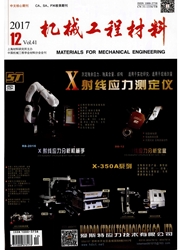

 中文摘要:
中文摘要:
根据7050铝合金的单级淬火试验结果设计了3组分级(三级)淬火工艺,研究了分级淬火主要工艺参数(喷水压力p、水流密度q、持续时间t)对硬度、表面残余应力及显微组织等的影响。结果表明:工艺参数对显微组织的影响较小;第一级淬火时采用较高喷水压力和较低水流密度能获得较大的淬硬深度;第二级淬火时提高水流密度比延长持续时间对试样的淬硬深度更有利,但后者的残余应力要小些;最佳的分级淬火工艺为第一级p=200kPa,q=48L·m^-2·s^-1,持续3s,第二级p=10kPa,q=90L·m^-2·s^-1,持续12s,第三级p=200kPa,q=130L·m^-2·s^-1,持续约480s。
 英文摘要:
英文摘要:
Based on the experimental results of single-stage quenching test, three kinds of multistage quenching processes were designed. The effect of spraying pressure (p), flux density (q) and duration (t) on the surface residual stress and the microstructure have been investigated. The results show that parameters had little effect on the microstruture. Adopting higher spraying pressure and lower flux density at the first stage of the quenching process can get a greater tempering depth. And increasing the flux density had the better effect on hardening depth than increasing the duration, but the latter had a lower residual stress. The best multistage quenching process was as following: the first stage (p=200 kPa,q=48 L· m^-2 · s^-1,t=3 s), the second stage (p =10kPa,q=90 L·m^-2 · s^-1, t=12 s), and the third stage (p:200kPa,q=130 L·m^-2 v s^-1,t=480 s).
 同期刊论文项目
同期刊论文项目
 同项目期刊论文
同项目期刊论文
 期刊信息
期刊信息
